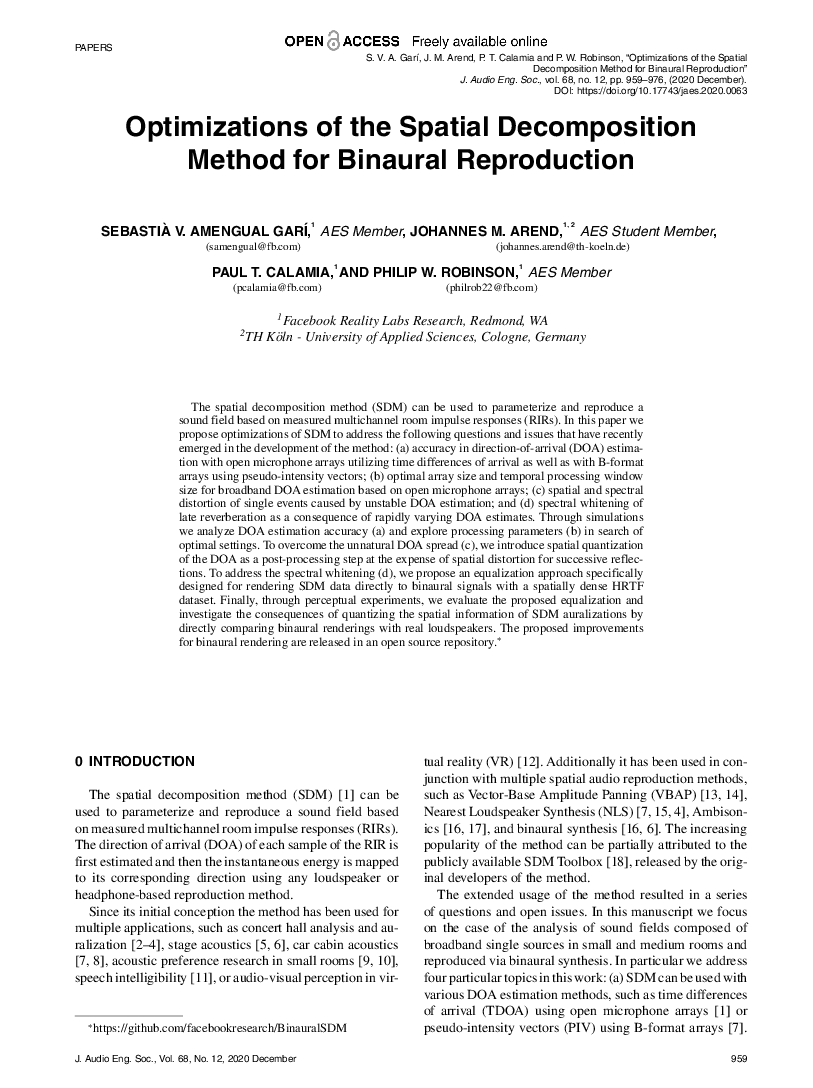Home / Publications / E-library page
You are currently logged in as an
Institutional Subscriber.
If you would like to logout,
please click on the button below.
Home / Publications / E-library page
Only AES members and Institutional Journal Subscribers can download
The spatial decomposition method (SDM) can be used to parameterize and reproduce a sound field based on measured multichannel room impulse responses (RIRs). In this paper we propose optimizations of SDM to address the following questions and issues that have recently emerged in the development of the method: (a) accuracy in direction-of-arrival (DOA) estimation with open microphone arrays utilizing time differences of arrival as well as with B-format arrays using pseudo-intensity vectors; (b) optimal array size and temporal processing window size for broadband DOA estimation based on open microphone arrays; (c) spatial and spectral distortion of single events caused by unstable DOA estimation; and (d) spectral whitening of late reverberation as a consequence of rapidly varying DOA estimates. Through simulations we analyze DOA estimation accuracy (a) and explore processing parameters (b) in search of optimal settings. To overcome the unnatural DOA spread (c), we introduce spatial quantization of the DOA as a post-processing step at the expense of spatial distortion for successive reflections. To address the spectral whitening (d), we propose an equalization approach specifically designed for rendering SDM data directly to binaural signals with a spatially dense HRTF dataset. Finally, through perceptual experiments, we evaluate the proposed equalization and investigate the consequences of quantizing the spatial information of SDM auralizations by directly comparing binaural renderings with real loudspeakers. The proposed improvements for binaural rendering are released in an open source repository.
Author (s): Amengual Garí, Sebastià V.; Arend, Johannes M.; Calamia, Paul T.; Robinson, Philip W.
Affiliation:
Facebook Reality Labs Research, Redmond, WA; Facebook Reality Labs Research, Redmond, WA; TH Köln - University of Applied Sciences, Cologne, Germany; Facebook Reality Labs Research, Redmond, WA; Facebook Reality Labs Research, Redmond, WA
(See document for exact affiliation information.)
Publication Date:
2020-12-06
Import into BibTeX
Permalink: https://aes2.org/publications/elibrary-page/?id=21010
(1483KB)
Click to purchase paper as a non-member or login as an AES member. If your company or school subscribes to the E-Library then switch to the institutional version. If you are not an AES member Join the AES. If you need to check your member status, login to the Member Portal.

Amengual Garí, Sebastià V.; Arend, Johannes M.; Calamia, Paul T.; Robinson, Philip W.; 2020; Optimizations of the Spatial Decomposition Method for Binaural Reproduction [PDF]; Facebook Reality Labs Research, Redmond, WA; Facebook Reality Labs Research, Redmond, WA; TH Köln - University of Applied Sciences, Cologne, Germany; Facebook Reality Labs Research, Redmond, WA; Facebook Reality Labs Research, Redmond, WA; Paper ; Available from: https://aes2.org/publications/elibrary-page/?id=21010
Amengual Garí, Sebastià V.; Arend, Johannes M.; Calamia, Paul T.; Robinson, Philip W.; Optimizations of the Spatial Decomposition Method for Binaural Reproduction [PDF]; Facebook Reality Labs Research, Redmond, WA; Facebook Reality Labs Research, Redmond, WA; TH Köln - University of Applied Sciences, Cologne, Germany; Facebook Reality Labs Research, Redmond, WA; Facebook Reality Labs Research, Redmond, WA; Paper ; 2020 Available: https://aes2.org/publications/elibrary-page/?id=21010
@article{amengual2020optimizations,
author={amengual garí sebastià v. and arend johannes m. and calamia paul t. and robinson philip w.},
journal={journal of the audio engineering society},
title={optimizations of the spatial decomposition method for binaural reproduction},
year={2020},
volume={68},
issue={12},
pages={959-976},
month={december},}
TY – paper
TI – Optimizations of the Spatial Decomposition Method for Binaural Reproduction
SP – 959 EP – 976
AU – Amengual Garí, Sebastià V.
AU – Arend, Johannes M.
AU – Calamia, Paul T.
AU – Robinson, Philip W.
PY – 2020
JO – Journal of the Audio Engineering Society
VO – 68
IS – 12
Y1 – December 2020